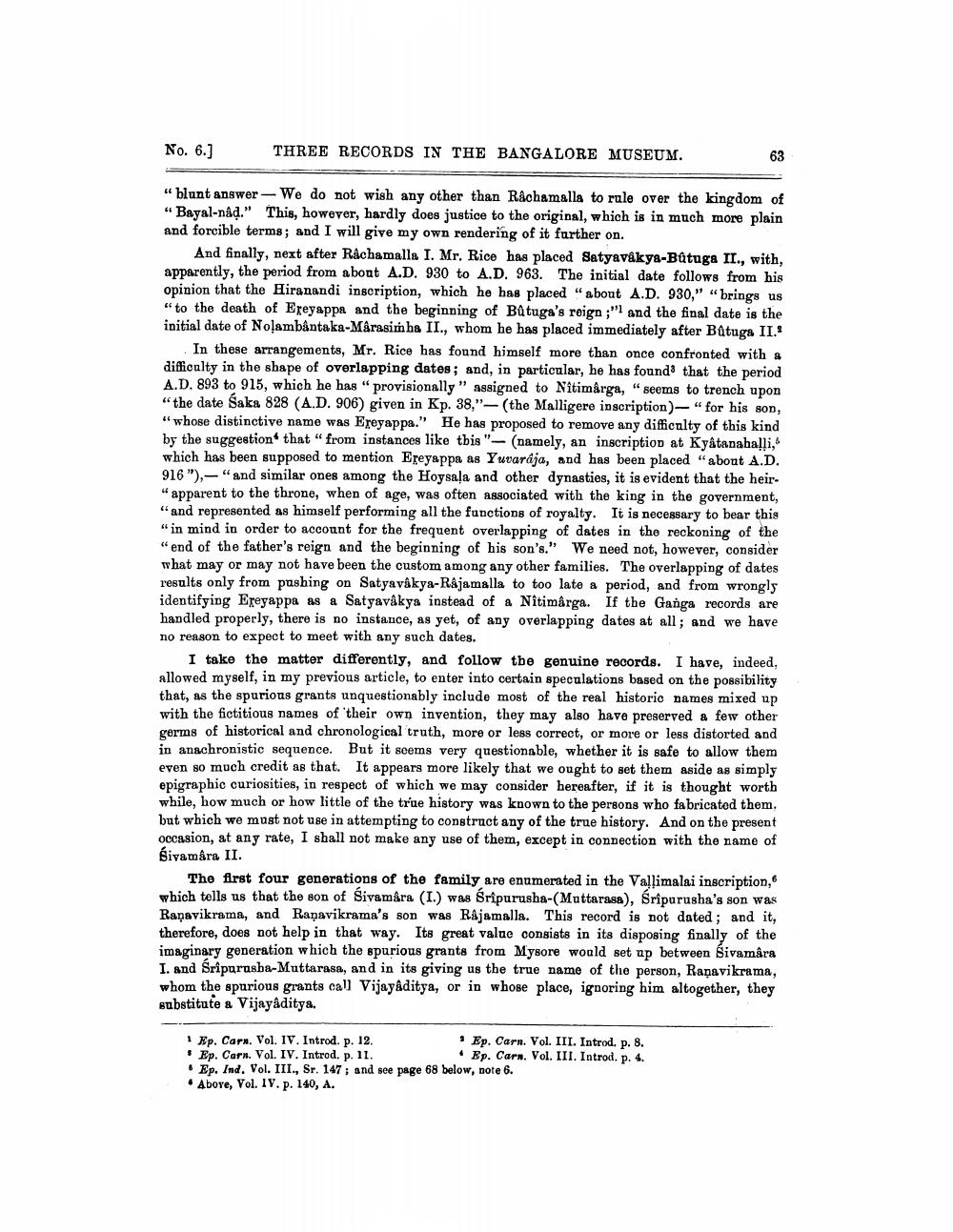________________
No. 6.]
THREE RECORDS IN THE BANGALORE MUSEUM.
- blunt answer - We do not wish any other than R&chamalla to rule over the kingdom of "Bayal-nad." This, however, hardly does justice to the original, which is in much more plain and forcible terms; and I will give my own rendering of it further on.
And finally, next after Rachamalla I. Mr. Rice has placed Satyavákya-Bütuga II., with, apparently, the period from about A.D. 930 to A.D. 963. The initial date follows from his opinion that the Hiranandi inscription, which he has placed "about A.D. 930," "brings us "to the death of Ereyappa and the beginning of BQ tuga's reign;" and the final date is the initial date of Nolambåntaka-Marasimha II., whom he has placed immediately after Batuga II.
In these arrangements, Mr. Rice has found himself more than once confronted with a difficulty in the shape of overlapping dates; and, in particular, he has found that the period A.D. 893 to 915, which he has provisionally" assigned to Nitimârga," seems to trench upon "the date Saka 828 (A.D. 906) given in Kp. 38,"-(the Malligere inscription)- " for his son, "whose distinctive name was Ereyappa." He has proposed to remove any difficnlty of this kind by the suggestion that " from instances like this "-(namely, an inscription at Kyâtanahalli, which has been supposed to mention Ereyappa as Yuvarája, and has been placed "about A.D. 916"), "and similar ones among the Hoysala and other dynasties, it is evident that the heir" apparent to the throne, when of age, was often associated with the king in the government, "and represented as himself performing all the functions of royalty. It is necessary to bear this "in mind in order to account for the frequent overlapping of dates in the reckoning of the "end of the father's reign and the beginning of his son's." We need not, however, consider what may or may not have been the custom among any other families. The overlapping of dates results only from pushing on Satyavákya-Rajamalla to too late a period, and from wrongly identifying Ereyappa as a Satyavákya instead of a Nitimârga. If the Ganga records are handled properly, there is no instance, as yet, of any overlapping dates at all; and we have no reason to expect to meet with any such dates.
I take the matter differently, and follow the genuine records. I have, indeed, allowed myself, in my previous article, to enter into certain speculations based on the possibility that, as the spurious grants unquestionably include most of the real historic names mixed up with the fictitious names of their own invention, they may also have preserved a few other germs of historical and chronological truth, more or less correct, or more or less distorted and in anachronistic sequence. But it seems very questionable, whether it is safe to allow them even so much credit as that. It appears more likely that we ought to set them aside as simply epigraphic curiosities, in respect of which we may consider hereafter, if it is thought worth while, how much or how little of the true history was known to the persons who fabricated them. but which we must not use in attempting to construct any of the true history. And on the present occasion, at any rate, I shall not make any use of them, except in connection with the name of sivamâra II.
The first four generations of the family are enumerated in the Vallimalai inscription, which tells us that the son of Sivamâra (I.) was Sripurusha-(Muttarasa), Sripurusha's son was Ranavikrama, and Raņavikrama's son was Rajamalla. This record is not dated ; and it, therefore, does not help in that way. Its great value consists in its disposing finally of the imaginary generation which the spurious grants from Mysore would set up between Sivamara I. and Sripurusba-Muttarasa, and in its giving us the true name of the person, Ranavikrama, whom the spurious grants call Vijayaditya, or in whose place, ignoring him altogether, they substitute & Vijayaditya.
1 Ep. Carn. Vol. IV. Introd. p. 12.
• Ep. Carn. Vol. III. Introd. p. 8. Ep. Carn. Vol. IV. Introd. p. 11.
• Bp. Carn. Vol. III. Introd. p. 4. . Ep. Ind. Vol. III., Sr. 147; and see page 68 below, note 6.
Above, Vol. IV. p. 140, A.




